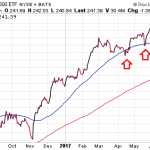“For all of us, the appropriate policy decision is going to be data dependent and all of us will be looking at the incoming data and our opinions about the appropriate timing of normalization are likely to shift as we look at how the data evolves.” – Janet Yellen, June 2015 FOMC Press Conference
“Data Dependent”
Janet Yellen and the Fed want you to know: they are “data dependent.” They aren’t just flying by the seat of their pants; they have a process by which they make monetary policy decisions. What that process is exactly is anyone’s guess, but “looking at the incoming data” seems to be a part of it.
Fair enough. The Fed has never been particularly good at making forward-looking assessments of the economy, so the best they can do is look at the recent past and project that into the future.
When the data weakens, they ease. When the data improves, they tighten. Or at least that’s how it used to work before the current cycle.
The Federal Funds rate was moved to 0% in December 2008 during the worst recession since the Great Depression. The U.S. economy entered an expansion in June 2009 and while it certainly has been below average in terms of the growth rate, we’ve come a long way since that point in time.
If we focus only on the economic data, there’s almost no justification for the Fed Funds rate to remain at 0%, the same level where it stood in the depths of the financial crisis when the Unemployment Rate stood at 10%. We can argue over whether it should be 1%, 2% or higher, but 0% does not seem rational given the “data.”
Click on picture to enlarge

Stock Market Tail Wags Fed Dog
If the Fed isn’t focusing on economic data, what exactly are they “looking at?” It is becoming increasingly obvious that when they say they are “data dependent” what they really mean is they are “S&P 500 and market volatility dependent.”














Leave A Comment